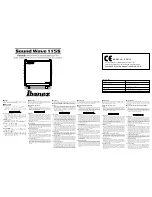
LCL - remote to local
Indicates whether a remote to local transition has occurred.
MSB - module summary bit
Indicates that an enable event in one of the module Status registers has
occurred.
Key Features
A few of the most important features of Status Reporting are listed in the
following paragraphs.
Operation Complete
The IEEE 488.2 structure provides one technique that can be used to find
out if any operation is finished. The
*OPC
command, when sent to the
instrument after the operation of interest, will set the OPC bit in the
Standard Event Status Register. If the OPC bit and the RQS bit have been
enabled, a service request will be generated. The commands that affect the
OPC bit are the overlapped commands.
Example
OUTPUT XXX;"*SRE 32 ; *ESE 1" !enables an OPC service
request
Status Byte
The Status Byte contains the basic status information which is sent over the
bus in a serial poll. If the device is requesting service (RQS set), and the
controller serial-polls the device, the RQS bit is cleared. The MSS (Master
Summary Status) bit (read with
*STB?
)
) and other bits of the Status Byte are
not be cleared by reading them. Only the RQS bit is cleared when read.
The Status Byte is cleared with the
*CLS
common command.
Status Reporting
Key Features
7–6
Summary of Contents for 16501A LOGIC
Page 2: ...ii ...
Page 12: ...Contents 8 ...
Page 14: ......
Page 15: ...1 Introduction to Programming ...
Page 38: ...1 24 ...
Page 39: ...2 Programming Over HP IB ...
Page 45: ...3 Programming Over RS 232 C ...
Page 55: ...4 Programming Over LAN ...
Page 68: ...4 14 ...
Page 69: ...5 Programming and Documentation Conventions ...
Page 81: ...6 Message Communication and System Functions ...
Page 91: ...7 Status Reporting ...
Page 93: ...Figure 7 1 Status Byte Structures and Concepts Status Reporting 7 3 ...
Page 97: ...Figure 7 2 Service Request Enabling Status Reporting Key Features 7 7 ...
Page 100: ...Figure 7 3 Parallel Poll Data Structure Status Reporting Parallel Poll 7 10 ...
Page 105: ...8 Error Messages ...
Page 110: ...8 6 ...
Page 112: ......
Page 113: ...9 Common Commands ...
Page 116: ...Figure 9 1 Common Commands Syntax Diagram Common Commands 9 4 ...
Page 122: ...Figure 9 2 IST Data Structure Common Commands IST Individual Status 9 10 ...
Page 132: ...9 20 ...
Page 133: ...10 Mainframe Commands ...
Page 135: ...Figure 10 1 Mainframe Commands Syntax Diagram Mainframe Commands 10 3 ...
Page 136: ...Figure 10 1 continued Mainframe Commands Syntax Diagram continued Mainframe Commands 10 4 ...
Page 159: ...11 SYSTem Subsystem ...
Page 161: ...Figure 11 1 System Subsystem Commands Syntax Diagram SYSTem Subsystem 11 3 ...
Page 172: ...11 14 ...
Page 173: ...12 MMEMory Subsystem ...
Page 175: ...Figure 12 1 MMEMory Subsystem Commands Syntax Diagram MMEMory Subsystem 12 3 ...
Page 198: ...12 26 ...
Page 199: ...13 INTermodule Subsystem ...
Page 201: ...Figure 13 1 Intermodule Subsystem Commands Syntax Diagram INTermodule Subsystem 13 3 ...
Page 216: ...13 18 ...
Page 217: ...14 TGTctrl Subsystem ...
Page 219: ...Figure 14 1 Targetcontrol Subsystem Commands Syntax Diagram TGTctrl Subsystem 14 3 ...
Page 220: ...Figure 14 1 continued Targetcontrol Subsystem Commands Syntax Diagram TGTctrl Subsystem 14 4 ...
Page 233: ...Part 3 15 Programming Examples 15 1 Programming Examples ...
Page 234: ......
Page 235: ...15 Programming Examples ...
















































